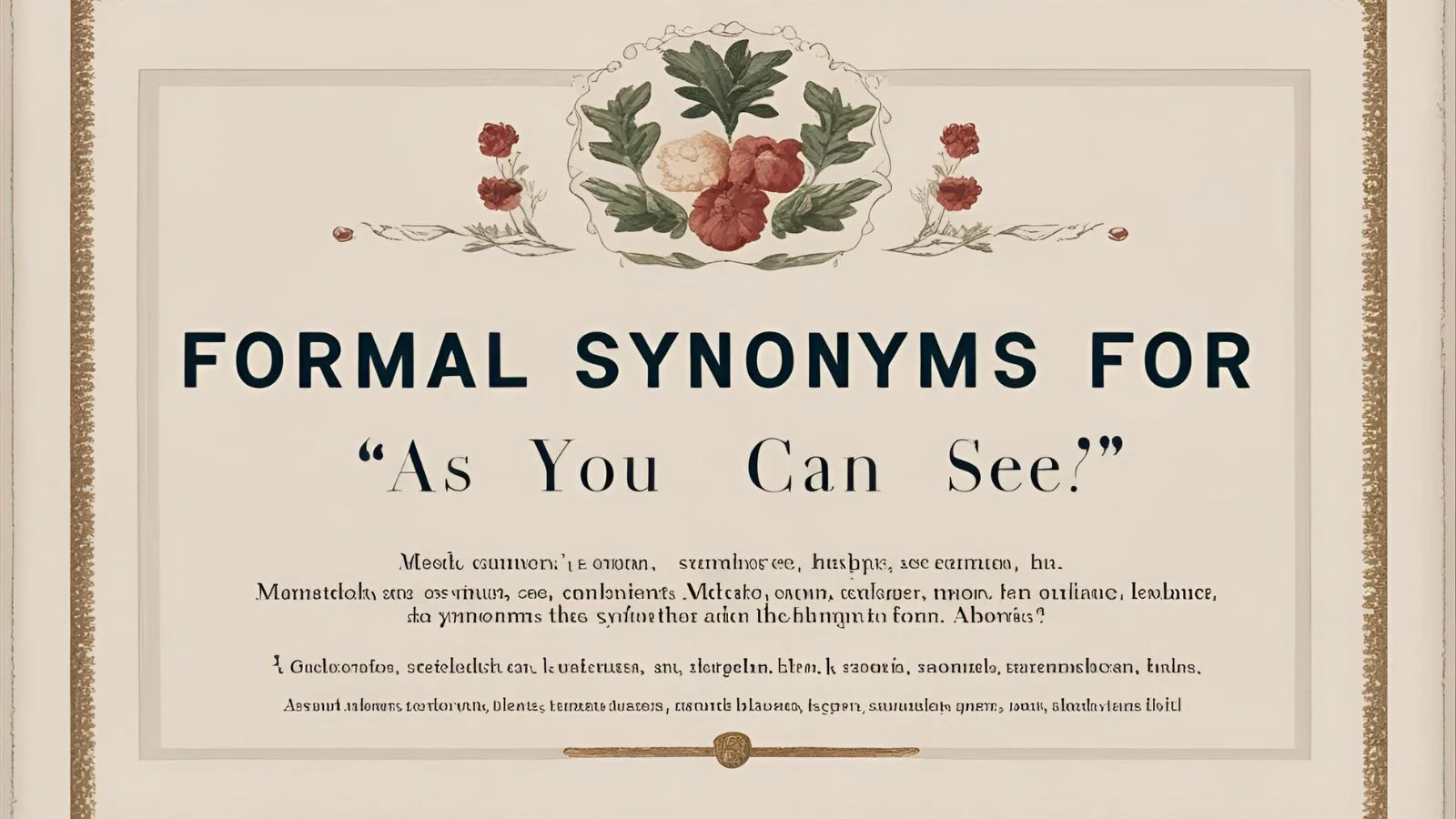In professional and academic writing, using precise and varied language enhances clarity and engagement. The phrase “as you can see” is commonly used to direct a reader or listener to a conclusion based on presented information. However, in formal contexts, it is essential to use more sophisticated alternatives. These synonyms not only improve the quality of writing but also ensure a polished and authoritative tone. Formal Synonyms for “As You Can See”.
Using formal alternatives to “as you can see” is beneficial in business reports, academic papers, and professional presentations. By selecting the right phrase, writers can effectively convey their message while maintaining credibility. The choice of synonym depends on the context, whether it involves data analysis, logical reasoning, or summarizing visual information. This article explores fifteen refined alternatives to “as you can see,” each with a detailed explanation and practical examples for effective usage.
By integrating these expressions into your writing, you can improve communication, establish professionalism, and enhance readability.
Evidently
Evidently is an effective alternative to “as you can see” when presenting clear and observable facts. It suggests that the information is apparent based on the provided evidence. This phrase is commonly used in formal writing, including research papers and analytical discussions.
For example, when interpreting statistical data, you might say, “Evidently, the increase in consumer spending correlates with economic recovery.” This demonstrates a logical conclusion drawn from presented information.
Using “evidently” also implies objectivity, as it indicates that the evidence speaks for itself. This makes it a strong choice for scientific reports, business analyses, and legal arguments. By incorporating “evidently” into your writing, you ensure that conclusions are based on clear, verifiable information. This synonym not only enhances professionalism but also strengthens the credibility of your statements.
Read More: Other Ways to Say “Please Confirm Receipt”
Clearly
Clearly is a direct and confident alternative to “as you can see,” often used in academic and business writing. It emphasizes that the information being presented is easy to understand or beyond dispute.
For instance, in a business report, one might write, “Clearly, the market trends indicate a shift towards digital services.” This expression highlights an obvious conclusion based on observable data.
Using “clearly” is effective in arguments where strong evidence is provided. It reassures the audience that the presented facts are logical and require little interpretation. However, it is important to use “clearly” with caution, as overuse may come across as dismissive or condescending.
By integrating “clearly” into your writing, you reinforce key points with confidence and authority. It is particularly useful when summarizing findings, making persuasive arguments, or drawing conclusions from research.
It Is Apparent That
“It is apparent that” is a polished and professional alternative to “as you can see.” This phrase indicates that the information is obvious or self-evident, making it suitable for formal documents, business reports, and research papers.
For example, in an economic analysis, you might write, “It is apparent that inflationary pressures have impacted consumer purchasing power.” This demonstrates a conclusion drawn from observable data.
This phrase is particularly useful when explaining trends, results, or patterns in a structured manner. Unlike casual expressions, “it is apparent that” conveys a neutral and objective tone, ensuring professionalism in writing.
By using “it is apparent that,” you guide the reader toward a logical conclusion without relying on personal opinion. This makes it an excellent choice for technical documents, legal writing, and scholarly articles.
Undoubtedly
Undoubtedly is a strong synonym for “as you can see,” emphasizing certainty and confidence. It is commonly used in persuasive writing, business communication, and analytical discussions.
For example, a financial report might state, “Undoubtedly, the company’s strategic investments have contributed to its growth.” This phrase asserts a well-supported conclusion based on evidence.
By using “undoubtedly,” writers can reinforce their arguments with a sense of authority. However, it is important to ensure that the claim is supported by solid evidence. Overuse of this phrase without justification may weaken credibility.
This synonym is particularly effective in concluding statements, executive summaries, and persuasive essays. It assures the reader that the presented information is not only logical but also indisputable.
As Demonstrated
“As demonstrated” is used to show that the evidence or facts presented have proven a particular point. It is often used in academic papers, research reports, and presentations to highlight supporting data.
For example: “As demonstrated in the graph above, the company’s growth has been consistent over the past five years.”
This synonym is ideal for discussions where evidence directly supports the argument being made. It emphasizes clarity and reinforces the logical flow of information.
As Illustrated
“As illustrated” can be used in formal contexts when referring to visual aids or examples that clarify a point. It adds a visual aspect to the argument and is commonly used in both written and spoken forms.
For example: “As illustrated by the case study, the new marketing strategy has significantly improved customer engagement.”
This expression is especially useful when referencing charts, graphs, or diagrams in professional settings. It lends authority to the conclusions drawn.
It Is Evident That
“It is evident that” is a polished way of stating that something is clear from the information presented. It is useful when summarizing key takeaways or drawing conclusions in formal writing.
For example: “It is evident that climate change is having a serious impact on global weather patterns.”
This synonym adds a tone of certainty, and it works well in analytical and persuasive writing where clear evidence supports the claim.
As Indicated
“As indicated” is another formal synonym used to refer to information that has been pointed out or suggested earlier in the conversation or text. It is common in reports and formal documents.
For example: “As indicated in the previous section, there is a clear correlation between income levels and education.”
This phrase is ideal for referencing specific points made earlier in a discussion and highlights direct connections.
As Reflected In
“As reflected in” can be used to demonstrate how something is evident or visible in a given example or situation. It adds a reflective tone and suggests that the evidence or conclusion is mirrored in the results or visuals.
For example: “As reflected in the survey results, customer satisfaction has improved over the past year.”
This synonym is great for analytical contexts where the outcome is presented in a way that clearly matches prior statements or evidence.
As Shown
“As shown” is straightforward and formal, often used when referring to data, images, or facts that have already been provided. It suggests that the reader or listener has seen the evidence firsthand.
For example: “As shown in the table, sales figures have doubled in the past quarter.”
It is particularly useful in presentations, reports, and any situation where the audience has access to direct evidence or visual aids.
As Depicted
“As depicted” is used when referring to something that has been represented or shown visually, whether in images, charts, or diagrams. It is a formal alternative suitable for professional or academic contexts.
For example: “As depicted in the chart, there has been a steady increase in the number of product users.”
This synonym works well when referencing visual representations of data, ensuring that the audience understands the link between the evidence and the conclusion.
This Suggests That
“This suggests that” is a refined way to present an inference based on the available evidence. It is commonly used in both scientific writing and persuasive communication to indicate a potential conclusion.
For example: “This suggests that further investigation into consumer behavior may yield important insights.”
It is ideal for professional settings where conclusions are drawn based on observable trends or patterns, adding a sense of logical reasoning to the argument.
The Data Confirms That
“The data confirms that” is a powerful alternative that directly links evidence with conclusions. It is often used in research and analytical reports to state that the data has validated the hypothesis or finding.
For example: “The data confirms that the new policy has resulted in a significant reduction in operational costs.”
This phrase enhances the authority of the claim, as it emphasizes that the data directly supports the conclusion being made.
In Light of This
“In light of this” is used to introduce a conclusion or observation based on previously presented information. It is a formal and effective way to wrap up an argument or present the next logical step.
For example: “In light of this, it is clear that further investments are necessary to achieve long-term growth.”
This synonym is suitable for concluding sections of reports, discussions, or presentations, especially when drawing on evidence to justify a decision or conclusion.
Conclusion
Selecting the right synonym for “as you can see” enhances clarity, professionalism, and credibility in writing. Each alternative discussed offers a unique way to present information, ensuring that your writing remains polished and authoritative. Whether you are drafting a business report, academic paper, or professional presentation, using varied expressions helps engage readers and convey conclusions effectively.
By replacing informal phrases with formal alternatives, you demonstrate expertise and command over the subject matter. This improves overall communication, making your arguments more persuasive and well-structured.
Incorporating these expressions into your writing ensures that your conclusions are presented with confidence and clarity. Mastering these synonyms will not only refine your writing style but also strengthen the impact of your message.










